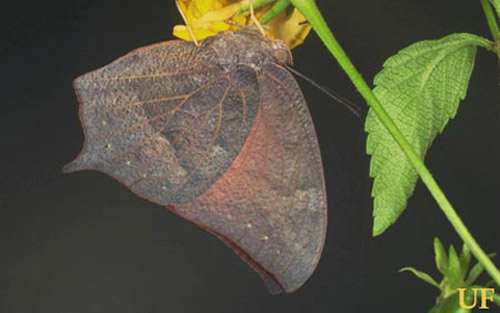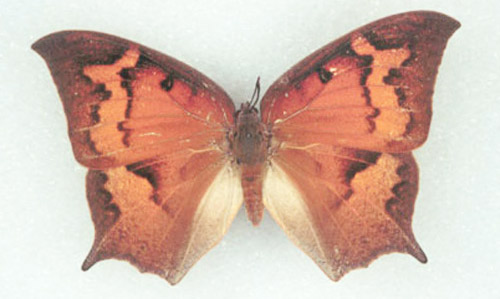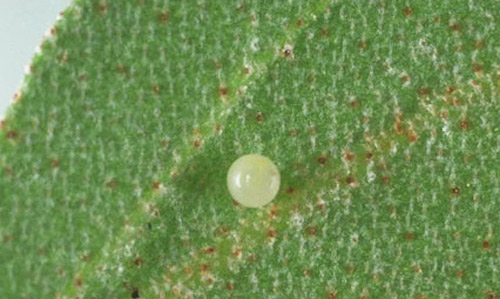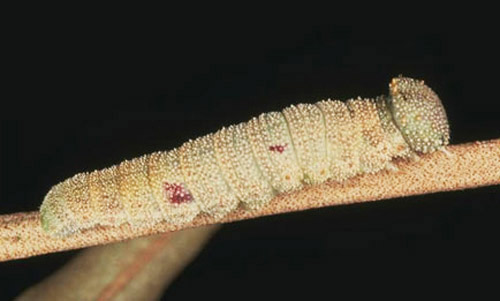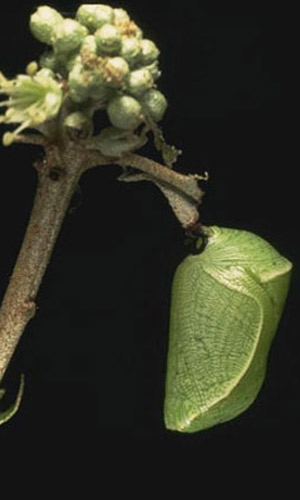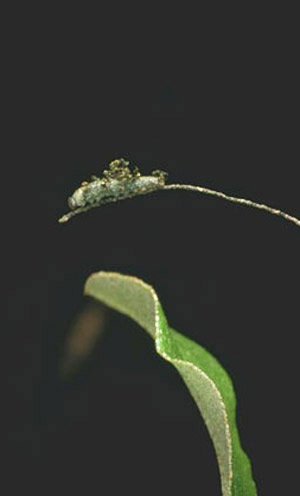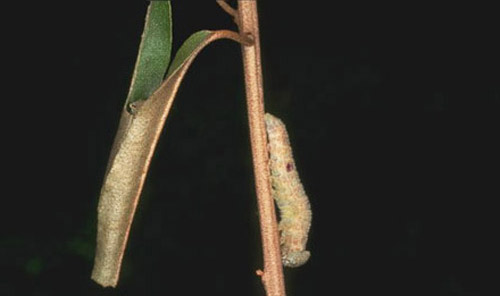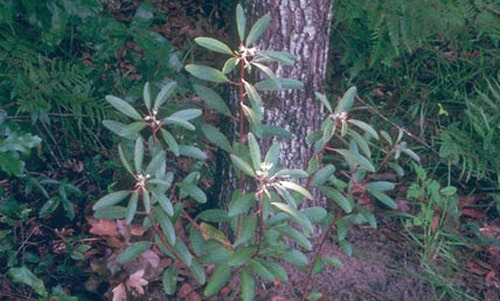common name: goatweed butterfly, goatweed emperor, goatweed leafwing
scientific name: Anaea andria Scudder 1875 (Insecta: Lepidoptera: Nymphalidae: Charaxinae)
Introduction - Distribution - Description - Life Cycle - Host Plants - Selected References
Introduction (Back to Top)
The goatweed butterfly is an attractive, fascinating and widespread species that is not often observed by the general public because of its cryptic coloration (Figure 1) and somewhat spotty distribution within its range. Both larvae and adults are cryptically colored. Adults play dead when handled (Scott 1986). This species provides dramatic examples of adaptive coloration and behavior to escape predators in both the larval and adult stages.
Figure 1. Resting goatweed butterfly, Anaea andria Scudder. Photograph by Jerry F. Butler, Entomology and Nematology Department, University of Florida.
Distribution (Back to Top)
The goatweed butterfly is widely distributed throughout the southern Midwest and South ranging from West Virginia to Kansas and south to Texas and Central Florida (Opler & Krizek 1984).
Description (Back to Top)
The wingspread of goatweed butterflies is 5.7 to 7.6 cm (2¼ to 3 inches) (Daniels 2003) with males being slightly smaller than females. The upper surface of the wings of adult goatweed butterflies exhibit sexual dimorphism in both shape and color (Figures 2 and 3). The wings of females have an irregular lighter submarginal band with broad darker margins. The apex of the forewing is hooked (falcate) and each hind wing bears a short, pointed, backward-projecting tail. Both sexes exhibit marked seasonal dimorphism in wing shape. In the summer forms, the forewing apex is less hooked and the hindwing tail is shorter than in the winter form. They also exhibit seasonal color dimorphism. Summer males are slightly less orange with a narrower marginal band. Summer females are lighter in color than winter females. The undersides of the wings mimic dead leaves and are similar in both sexes.
Both the appearance of the adult seasonal forms and reproductive diapause in the winter forms are controlled by responses of the larvae to photoperiod (daylength) (Riley 1988a, Riley 1988b). Larvae exposed to short photoperiods during late summer and early fall produce winter form adults that are in reproductive diapause.
Figure 2. Summer form of male goatweed butterfly, Anaea andria Scudder. Photograph by Jerry F. Butler, Entomology and Nematology Department, University of Florida.
Figure 3. Summer form of adult female goatweed butterfly, Anaea andria Scudder. Photograph by Jerry F. Butler, Entomology and Nematology Department, University of Florida.
Eggs are spherical and cream colored (Figure 4).
Figure 4. Egg of goatweed butterfly, Anaea andria Scudder. Photograph by Jerry F. Butler, Entomology and Nematology Department, University of Florida.
Full-grown larvae are approximately 3.8 cm in length and are grey-green with many minute tubercles covering both the head and body (Figure 5). The head also has a small number of larger orange tubercles. The color and tuberculation of the larvae match the surface texture and appearance of twigs of some common host plants.
Figure 5. Full grown caterpillar of goatweed butterfly, Anaea andria Scudder. Photograph by Jerry F. Butler, Entomology and Nematology Department, University of Florida.
Pupae are light green with darker green lines simulating a leaf-like texture (Figure 6). There is a small heavily sclerotized black anal ring just below (anterior to) the cremaster.
Figure 6. Pupa of goatweed butterfly, Anaea andria Scudder. Photograph by Jerry F. Butler, Entomology and Nematology Department, University of Florida.
Life Cycle (Back to Top)
The goatweed butterfly has two flights per year in the North with possibly three or four flights in parts of the South (Scott 1986). Their flight is swift and erratic (Opler & Krizek 1984). Overwintering adults mate in the spring (Scott 1986). Males wait for females for mating in clearings or on ridge tops.
Adults feed on sap flows, decaying fruits, and dung (Heitzman & Heitzman 1987). The proboscis is too short to allow feeding on most flowers (Scott 1986). Goatweed butterflies are found in open wooded areas (particularly sandhills) and along edges of hammocks near streams (Glassberg et al. 2000).
Eggs are laid on new growth of the host plants (Minno et al. 2005). First and second instar larvae eat the leaf blade away from the midrib and rest at the tip. They attach fecal pellets with silk to their backs and to the base of the leaf midrib (Figure 7) - probably to repel ants and other predators. Older larvae fold and silk the sides of leaves together and hide inside with their heavily sclerotized heads blocking the entrance to the leaf roll (Minno et al. 2005). (Figure 8). Larvae often pupate on the undersides of leaves of the host plant (Heitzman & Heitzman 1987).
Figure 7. Second instar larva of goatweed butterfly, Anaea andria Scudder, resting at tip of leaf midrib. Photograph by Jerry F. Butler, Entomology and Nematology Department, University of Florida.
Figure 8. Goatweed butterfly larvae (one on stem, one in leaf roll), Anaea andria Scudder. Photograph by Jerry F. Butler, Entomology and Nematology Department, University of Florida.
Hosts (Back to Top)
Larval hosts for the goatweed butterfly are various species of plants in the genus Croton (Euphorbiaceae). A commonly used host-plant species in central Florida is silver croton, Croton argyranthemus Michx. (Figure 9) a common inhabitant of long leaf pine (Pinus palustris Mill.) high pine communities.
The pine sandhill and scrub habitats that support silver croton are rapidly diminishing in Florida and elsewhere because of urban encroachment (Cech & Tudor 2005).
Figure 9. Silver croton, Croton argyranthemus Michx., host for goatweed butterfly, Anaea andria Scudder. Photograph by Donald W. Hall, Entomology and Nematology Department, University of Florida.
Selected References (Back to Top)
- Cech R, Tudor G. 2005. Butterflies of the East Coast: An Observer’s Guide. Princeton University Press. Princeton, New Jersey. 345 pp.
- Daniels JC. 2003. Butterflies of Florida. Adventure Publications. Cambridge, Minnesota. 256 pp.
- Glassberg J, Minno MC, Calhoun JV. 2000. Butterflies Through Binoculars: A Field, Finding, and Gardening Guide to Butterflies in Florida. Oxford University Press. New York. 242 pp.
- Heitzman JR, Heitzman JE. 1987. Butterflies and Moths of Missouri. Missouri Department of Conservation. Jefferson City, MO.
- Minno MC, Butler JF, Hall DW. 2005. Florida Butterfly Caterpillars and their Host Plants. University Press of Florida. Gainesville, Florida. 341 pp.
- Opler PA, Krizek GO. 1984. Butterflies East of the Great Plains. The Johns Hopkins University Press. Baltimore, MD.
- Riley TJ. 1988a. Effect of larval photoperiod on incidence of adult seasonal forms in Anaea andria (Lepidoptera: Nymphalidae). Journal of the Kansas Entomological Society 61: 224-227.
- Riley TJ. 1988b. Effect of larval photoperiod on mating and reproductive diapause in seasonal forms of Anaea andria (Nymphalidae). Journal of the Lepidopterists' Society 42: 263-268.
- Scott JA. 1986. The Butterflies of North America. Stanford University Press. Stanford, CA.
